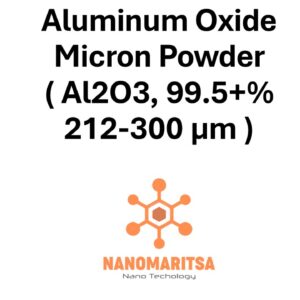Aluminum Oxide Micron Powder (Al₂O₃, 99.5+%, 22–59 µm) is a high-purity alumina powder widely recognized for its excellent hardness, chemical resistance, and thermal stability. Featuring a particle size range of 22 to 59 micrometers, this powder is ideal for applications requiring coarser particles with enhanced flowability, such as powder metallurgy, abrasives, thermal coatings, and industrial manufacturing processes. Its 99.5+% purity ensures minimal impurities, making it a reliable choice for demanding applications in industries such as aerospace, automotive, and energy.
1. Key Properties
High Purity (≥99.5%) The high purity level minimizes contamination, ensuring consistent and reliable performance in critical applications such as advanced ceramics, protective coatings, and abrasives.
Particle Size (22–59 µm) The coarser particle size offers improved flow characteristics and reduced agglomeration, supporting efficient processing in powder-based manufacturing and coating applications.
Exceptional Hardness With a hardness near 9 on the Mohs scale, alumina is ideal for wear-resistant applications, including abrasives, grinding tools, and protective coatings.
Thermal Stability Aluminum oxide withstands temperatures exceeding 2,000 °C, maintaining structural integrity in extreme heat, which is essential for refractory and high-temperature applications.
Chemical Inertness Alumina’s resistance to acids, alkalis, and chemical solvents ensures durability in corrosive environments, such as chemical processing and filtration systems.
2. Applications
Advanced Ceramics & Refractories Alumina powder is used in high-performance ceramics and refractory materials, such as kiln furniture, nozzles, and components that require exceptional heat and wear resistance.
Abrasives & Polishing The 22–59 µm particle size is well-suited for producing grinding wheels, cutting tools, and polishing media for industrial and precision applications.
Thermal Barrier Coatings Alumina-based coatings protect engine components, turbine blades, and industrial equipment from extreme heat, oxidation, and erosion.
Electronics & Insulation Alumina’s dielectric properties and thermal conductivity make it an essential material for substrates, circuit boards, and protective housings in electronic devices.
Catalysis & Filtration High-purity alumina is used as a catalyst support and in filtration systems that require resistance to high temperatures and corrosive environments.
3. Advantages
Improved Flowability The coarser particle size enhances flow properties, making it easier to handle during manufacturing processes such as sintering, spraying, and pressing.
Wear & Abrasion Resistance Alumina’s extreme hardness extends the lifespan of components, tools, and coatings exposed to abrasive or high-friction conditions.
High-Temperature Performance Alumina maintains its mechanical properties under extreme heat, making it ideal for refractory linings, thermal barriers, and high-temperature processing.
Chemical Stability Resistance to aggressive chemicals enhances the durability of alumina-based products in chemical and industrial applications.
Electrical Insulation Alumina’s high dielectric strength and low electrical conductivity make it suitable for insulating components in high-voltage and high-temperature electronic systems.
4. Recent Trends and Research
Additive Manufacturing Research is expanding into the use of coarser alumina powders in binder jetting and direct energy deposition methods for producing complex, durable ceramic parts.
Advanced Coating Techniques Innovations in plasma spraying, high-velocity oxy-fuel (HVOF), and sol-gel methods are improving the performance and application range of alumina-based coatings.
Optimized Abrasives Efforts to enhance alumina abrasives focus on improving cutting efficiency, reducing wear, and achieving higher precision in industrial and consumer applications.
Sustainability Initiatives Recycling alumina abrasives and ceramic waste is becoming more prevalent, reducing raw material costs and aligning with environmental sustainability goals.
Energy Sector Applications Alumina is playing a growing role in catalysis, energy storage systems, and filtration technologies as industries adopt cleaner, more efficient processes.
5. Future Prospects
Enhanced Ceramic Manufacturing Advances in powder processing and sintering techniques will enable the production of more intricate and high-performance alumina ceramic components.
Thermal Barrier Innovations Alumina’s ability to withstand extreme temperatures will drive its adoption in advanced coatings for aerospace, energy, and automotive applications.
Bioceramics & Medical Tools Alumina’s biocompatibility and wear resistance make it a strong candidate for medical implants, surgical instruments, and dental devices.
Lightweight Composites Alumina-reinforced composites are expected to play a larger role in automotive and aerospace applications, offering high strength-to-weight ratios for improved efficiency.
Clean Energy Solutions Alumina’s role in catalysis, filtration, and energy storage systems will expand as industries focus on sustainable and efficient technologies.
With its 99.5+% purity and 22–59 µm particle size range, Aluminum Oxide Micron Powder (Al₂O₃, 99.5+%, 22–59 µm) delivers outstanding durability, thermal stability, and wear resistance for a variety of industrial and high-performance applications. From advanced ceramics and abrasives to protective coatings and electronic components, alumina continues to be a cornerstone material for cutting-edge manufacturing and engineering.
| Measurement (gr) | 100 grams, 500 grams, 1000 grams |
|---|






